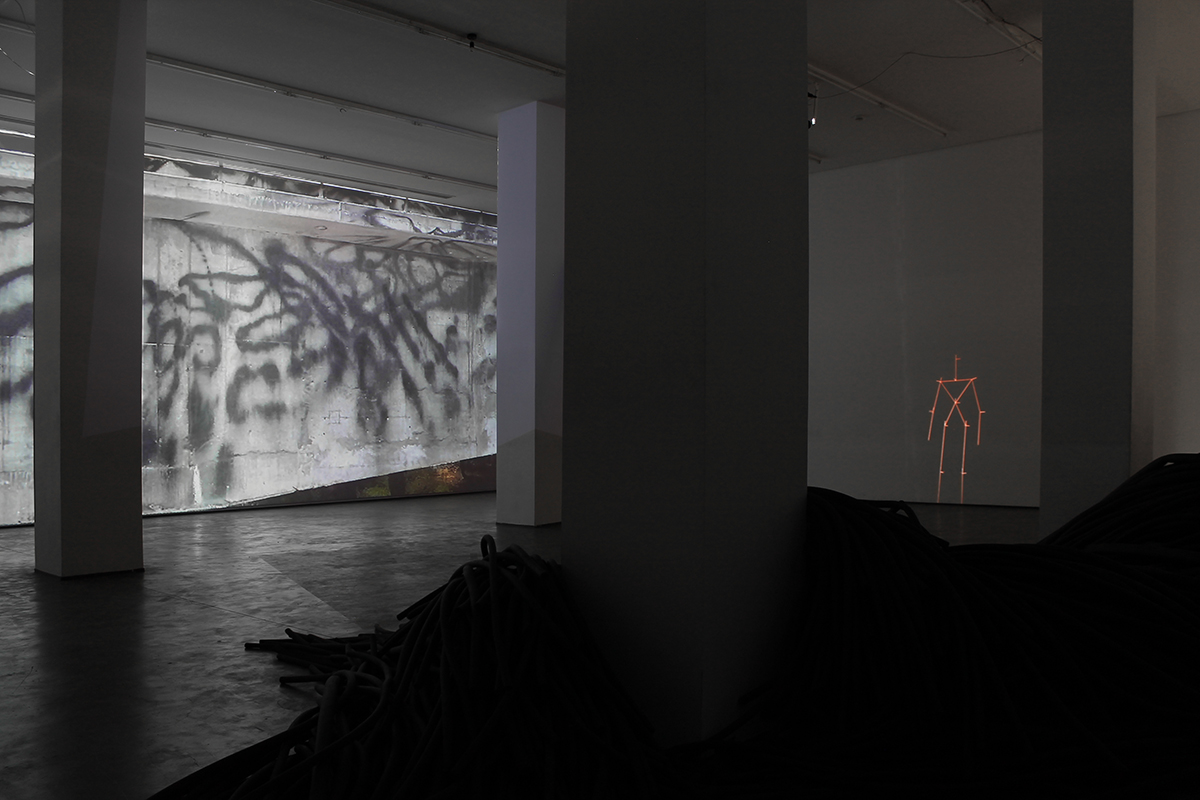KERNEL, “Γέφυρα”
Friday, 27 May to 24 June 2016
Epikourou 26 & Korinis 4
Two years ago, we climbed up a hill situated on the edge of the Athenian suburbs. The specific hill is connected with its opposite twin hill by a railway bridge. We had seen this bridge several times before in the past. We had been passing tens of meters beneath it, traveling with buses on the highway that runs between the two hills. We got on the bridge by following a wide uphill path. Then, we climbed up a short but steep slope that was covered with red soil and harsh rocks. We finally passed through the violated mesh of a rusty steel fence that forbid the entrance to the passers-by. To our right, the city took the form of a white mass, composed by thousands of packed dots. To the left, we had a view of the port, of a silver sea and the coastline of the nearby island. Shipyards, factories and small settlements were scattered around the valley. Transmission towers were crowning the top of the opposite cliff. Cypresses and pines created a deep green layer beneath us.
We decided to climb up the hill and get to the bridge, after we heard of an incident that happened on the railway’s inaugural journey. The event got no press, apart from an article in a local blog. What the train driver reported was an impact that happened inside the railway’s tunnel. According to his story, the engine that pulled the thirty-eight container wagons of the train, collided with an improvised barricade. It was a stack composed of a huge cable coil made of wood, of lighting tubes and piled metallic trays. The later were ripped-off from inside the tunnel. The wooden coil must have been rolled up to that point, all the way up the steep slope, barely passing through the opening of the mesh fence. The train crashed on the unexpected obstruction. There were no significant casualties, so the engine and the thirty-eight containers continued their route. However, the mysterious sabotage was repeated on the train’s return journey. The same people that built up the stack in the first place, were probably the ones that installed it again, more or less in the same spot as before. Like in the first attempt, no remarkable damage was caused. As the train driver reported, the result was just the delay of the service, in order for the tunnel to be cleaned up from the scattered wood, the destroyed lighting tubes and the deformed metal that was still obstructing the rails.
The bridge was built some years ago as part of a greater infrastructural project, a commercial railway of foreign interests. The railway was supposed to expand the national railway network, by specifically connecting the industrial areas around Athens with the Piraeus port. To our knowledge, no one claimed the action of the sabotage in the railway’s tunnel.
The first time we visited the bridge we thought that we would find some evidence of the train’s double collision. We found nothing. Probably because the nearby tunnel that perforates the specific hill is not the only one along the length of the railway. We climbed up the same path some months later. Nothing seemed to have changed. We saw the same view. The port and the shipyards. The factories and the villages. The transmission towers, the cypresses and the pines. That time, we decided to cross the bridge all the way through, and climb down to reach the highway from the opposite hill. The iron rails looked still impressively new. The gray-green stone that was laying in between the rails looked freshly paved.
However, this time, the surface of the two sides of the bridge was covered in its entirety with forms of black paint. The whole image was so abstract and curious that it was difficult to say if the composition that was unfolding in front of us was an intended human intervention, or a strange material reaction that took place on the gray cement. The perplexity and chaos of what could possibly be described as a mural, looked like the residue of organically orchestrated movements. Like traces of processes and conflicts. These illegible inscriptions seemed to have sprung up from the landscape in the same mysterious way that the surrounding hills, the trees and the impressive infrastructural constructions had emerged. We took some pictures of the dark surface, without having decided about the origin of the vast painting. However, at the point where the bridge touches the slope of the hill that we finally reached, just where we took the path of returning, we saw a sprayed inscription consisting of three letters: “OFK”.
We finally started climbing down the hill. Within the warm and clear afternoon atmosphere, the rustling of the trees was competing with the confusing whistling of the highway. The delirious traffic was carrying bodies to the city and the suburbs, the shipyards and the factories. Like a torrent, it was dragging with it local produce, imported goods, stolen and recycled matter. At the middle of our journey we heard a loud noise. It sounded like giant rocks were rolling down the hill, or trees being uprooted by a strong wind. Between the cypresses, we saw the engine passing through the railway’s route. After a couple of seconds, it had disappeared inside the stone hill. It was the first and last time that we ever actually saw the train.
Last year, we exhibited one of the pictures that we took that day from the surface of the bridge. We included the signature that we discovered in the title of that photo. About a month later, we got an email from a funny account name. The content of the email was signed as “Ofrah Fergal Kasei”. It included one single question: Why you climbed up that bridge?
We are still working on an answer.

